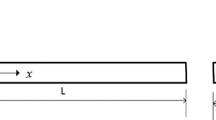Abstract
One of the most important tasks in dynamic experimentation and empirical modal analysis is the study of structural responses to a variety of excitations. Generally, such responses can be received from different point parts of a structure. Frequency and time domain analyses utilize these responses to provide information on dynamic features of a structure such as resonance frequency, modal shape, and modal damping. In recent years, there has been widespread progress in the production of micro-electromechanical sensors, and cell phones and other gadgets have utilized this technology. In the following paper, the MPU 6050 module is introduced. Then, the process of implementation and coding of this module is described. Finally, to evaluate the data collecting quality of this module, the results of the experimental models are compared with the finite element results, and the conclusion is made.











Similar content being viewed by others
References
Ajorloo Y, Ghaffarzadeh H (2017) Identification of structural dynamic parameters using block pulse functions and recursive least-squares algorithm. Iran J Sci Technol Trans Civ Eng 41(2):149–158
Angelkirk A, Mateisen W (1957) Damage detection and localization using natural frequency changes. In: Proceedings of conference on identification in engineering systems, pp 102–109
Brincker R, Ventura C (2015) Introduction to operational modal analysis. Wiley, Oxford
Chery B, Brudy S (1959) Detection of structural failure on fixed platforms by measurement of dynamic response. J Petrol 29(03):305–310
Domaneschi M, Pina M, Martinelli L (2013) Vibration based damage localization using MEMS on a suspension bridge model. Smart Struct Syst 12(6):679–694
Ewins D (2000) Modal testing: theory, practice, and application. Research Studies Press, Michigan
Ferdoush S, Li X (2014) Wireless sensor network system design using raspberry pi and arduino for environmental monitoring applications. Procedia Comput Sci 34:103–110
Fu Z-F, He J (2001) Modal analysis. Publisher - Butterworth-Heinemann, Butterworth-Heinemann, Oxford. ISBN 9780080511788
Galdino E, Cury A (2016) Development of low-cost wireless accelerometer for structural dynamic monitoring. In: Proceedings of the XXXVII Iberian Latin-American congress on computational methods in engineering, Brasília, DF, Brazil, November 6–9, 2016
Hanison SR, Vanderplaats GN (1965) Approximation method for configuration optimization of trusses. AIAA J 28(1):161–168
Harris FJ (1978) On the use of windows for harmonic analysis with the discrete fourier transform. In: Proceedings of the IEEE, vol 66
Jeong T, Kim T, Hyung P, Hong D, Ho D (2011) Hybrid acceleration-impedance sensor nodes on Imote2-platform for damage monitoring in steel girder connections. Smart Struct Syst 7(5):393–416
Nihtianov A, Luque R (2013) Smart sensors and MEMS, 1st edn. Publishing by Woodhead, Derbyshire
Norton HN (1989) Handbook of transducers. Prentice Hall PTR, Prentice Hall, Upper Saddle River. ISBN 0-13-382599-X
Pandey S, Haider M, Uddin N (2016) Design and implementation of a low-cost wireless platform for remote bridge health monitoring. Int J Emerg Technol Adv Eng 6(6):57–62
Rahami H, Ghodrati G, Amini Tehrani A, Akhavat M (2018) Structural health monitoring for multi-story shear frames based on signal processing approach. Iran J Sci Technol Trans Civ Eng. https://doi.org/10.1007/s40996-018-0096-1
Roitman N, Viero PF, Magluta C, Batista RC, Rosa LFL (1992) Identification of offshore platform structural damage using modal analysis techniques. Mech Syst Signal Process 6(3):287–295
Saboonchi H, Ozevin D, Kabir M (2016) Acoustic emission and strain. Sens Actuators A Phys 247:566–578
Sergey YY, Gomes MTSR (2003), Smart sensors and MEMS. by NATO Advanced Study Institute on Smart Sensors and MEMS
Shabbir F, Omenzetter P (2008) Forced vibration testing of a thirteen-store concrete building. In: NZSEE conference, Wellington, New Zealand, April
Sindhu SA, Nirrmala CA (2015) Structural health monitoring using wireless sensor network. Int J Emerg Technol Comput Sci Electron 13(4):319–322
Takewaki I, Nakamura M, Yoshitomi S (2012) System identification for structural health monitoring. WIT Press, Ashurst, Southampton
Vetterli M, Kovaevi J, Goyal VK (2014) Foundations of signal processing. Published by Cambridge University, Cambridge
Walter PL (2006) The history of the accelerometer 1920’s–1996. Prologue and Epilogue, New York
Wang Y, Chi Z (2016) System of wireless temperature and humidity monitoring based on arduino unio platform. In: 2016 Sixth international conference on communication and control (IMCCC), Harbin, China, July
Wullff G, Vanorden RC (1979) Evaluation of earthquake stability of lower Springs Dam California—U.S.A. In: Proceedings of the 13th international congress on large dam, New Delhi, India, October
Yu Y, Ou J, Li H (2010) Design, calibration and application of wireless sensors for structural global and local monitoring of civil infrastructures. Smart Struct Syst 6(5):641–659
Acknowledgement
Hossein Rahami would like to acknowledge the financial support of University of Tehran for this research under Grant Number 27938/01/18.
Author information
Authors and Affiliations
Corresponding author
Appendix
Appendix
The code is written to connect the MPU6050 accelerometer module to the Arduino controlling board in the Arduino software.

Rights and permissions
About this article
Cite this article
Babakhani, B., Rahami, H. & Karami Mohammadi, R. Determining Structural Resonance Frequency via Low-Cost Micro-Electromechanical Systems. Iran J Sci Technol Trans Civ Eng 43 (Suppl 1), 583–590 (2019). https://doi.org/10.1007/s40996-018-0188-y
Received:
Accepted:
Published:
Issue Date:
DOI: https://doi.org/10.1007/s40996-018-0188-y




